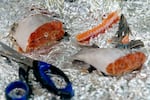
Laboratory analyst Cody Lukken processes salmon filets for testing at a lab in Washington.
Kristyna Wentz-Graff / OPB
Oregon Public Broadcasting and ProPublica reporters conducted interviews and listening sessions with tribal leaders, toxicologists and public health experts, many of whom became informal advisers throughout the project. Tribal leaders expressed support and interest in additional fish testing. Based on these conversations, the reporters developed a preliminary methodology to test salmon for toxics in a stretch of the Columbia River. This methodology followed standard fish tissue testing methods. The reporters sent this methodology to the same informal advisers for review.
A reporter purchased 50 salmon from tribal fishers upriver of the Bonneville Dam, in the zone of the river reserved for tribal treaty fishing. The majority of the fish were fall Chinook salmon, with two coho salmon and one steelhead. The fish were caught in late September 2021. With the salmon in hand, a reporter gutted the fish, removed the heads and cut them into pieces so they would fit into five coolers. The fish were placed on ice in five different coolers, with 10 fish of roughly the same size placed in each cooler.
Testing of fish can be done on the whole body of the fish, on a fillet with the skin on or on a fillet with the skin removed. Although many people, particularly in tribal communities, consume the head of the fish, reporters asked the laboratory to test fillets with skin because it was determined to capture the best approximation of what’s most often consumed in tribal diets.
Related: Unchecked pollution is contaminating the salmon that Pacific Northwest tribes eat
A reporter sent the fish samples to ALS, a certified laboratory, and followed ALS protocols for the collection and delivery of samples. The laboratory combined fish to create five new composite samples, each one with 10 fish. (Creating composite samples enables more fish to be tested without raising laboratory costs.) Then, ALS technicians conducted testing to assess levels of 13 metals and two classes of chemicals in each of the five fish samples. In March 2022, ALS sent OPB and ProPublica an analytical report that included the case narrative, chain of custody and testing results, which we again shared with experts and public health officials as we developed a plan to analyze the results.
As a first step, the reporters conducted quality assurance checks on the testing and processed the data. While doing so, the reporters encountered testing limitations that prompted them to make two choices that are standard in both national and international approaches to fish toxics testing:
- ALS tested for general mercury, yet methylmercury is the form that is most concerning to public health. The Environmental Protection Agency and European Food Safety Authority assume 100% of mercury sampled in fish tissue is methylmercury. The reporters adopted the same approach.
- ALS tested for arsenic, yet inorganic arsenic is the form that is most concerning to public health. The reporters found that there isn’t as much of a cohesive approach toward identifying the proportion of arsenic that is inorganic without directly testing for it. The Idaho Department of Environmental Quality recently launched a sampling effort in which researchers found that, on average, about 4% of the arsenic in fish is inorganic. The department’s study is one of the most robust examinations of inorganic arsenic concentrations near the Columbia River. The Oregon Health Authority takes a different approach. David Farrer, a toxicologist with the agency, said they would initially assume 10% of arsenic is inorganic and, if the results signaled the levels could harm human health, they would then reanalyze any leftover sample specifically for inorganic arsenic. If that were not possible, the health department would not use the data at all. Given these uncertainties, OPB and ProPublica chose not to move forward with assessing cancer risk of inorganic arsenic since the news organizations did not specifically test for it.
The reporters then calculated the average concentration of chemicals across each of the wet weight samples. They then assessed how these results compared to EPA, Oregon Health Authority and Washington Department of Health standards.
Of the 13 metals and two classes of chemicals tested, three contaminants surpassed federal and local standards at varying levels of fish consumption: mercury, or methylmercury; polychlorinated biphenyls, or PCBs; and dioxins/furans.
The reporters shared their methodology and findings with experts for review. Toxicologists with the Oregon Health Authority and the Washington Department of Health, as well as former and current EPA scientists, reviewed the results and, in some cases, conducted their own calculations to assess how the testing findings compared to their respective standards. The reporters then met with each of these individuals to talk through the findings, ask and answer questions, and ultimately update their own findings to incorporate feedback. The experts’ feedback was consistent with one another. This process led to the finding that concentrations of mercury (methylmercury) and PCBs would warrant the EPA and at least one state health agency to recommend eating no more than eight 8-ounce servings of salmon in a month. The equation used for these calculations can be found in this Oregon Health Authority report (Page 4) and this Washington Department of Health report (Page 35).
Simultaneously, OPB and ProPublica calculated the estimated cancer risk from consuming salmon with the contaminant levels found through our testing. For each contaminant, a reporter calculated the levels of exposure for multiple scenarios based on how different populations eat, including general population consumption and average and high rates for Columbia River tribes, which were based on consumption surveys. The amount of contamination assumed in this calculation was taken from the 95% upper confidence limit of the test results. Current and former EPA scientists reviewed the methodology and calculations.
To calculate lifetime cancer risk, the dose of a probable carcinogen must be multiplied by a cancer potency factor, which estimates toxicity. Cancer potency factors, also known as slope factors, were sourced from this EPA report. Former and current EPA officials, as well as an epidemiologist, reviewed the calculations and results.
We also factored in the following consideration: Under EPA guidance, when calculating safe levels of exposure to different chemicals, the agency calculates monthly limits to the exact number of meals a person should eat. But it then rounds that down to the nearest multiple of four in an effort to make risk communication easier to follow. For example, if one were to find that the levels of dioxins would warrant that someone only eat five fish per month to avoid excess cancer risks, that would be rounded down to the four fish per month.
Ultimately, this led to the finding that, based on the levels of dioxins in our samples, anything above four 8-ounce servings of these tested fish each month would create an excess cancer risk beyond the EPA’s benchmark of 1 in 100,000. That means of 100,000 people exposed to these levels of contaminants, one of them would develop cancer as a result of the exposure.




